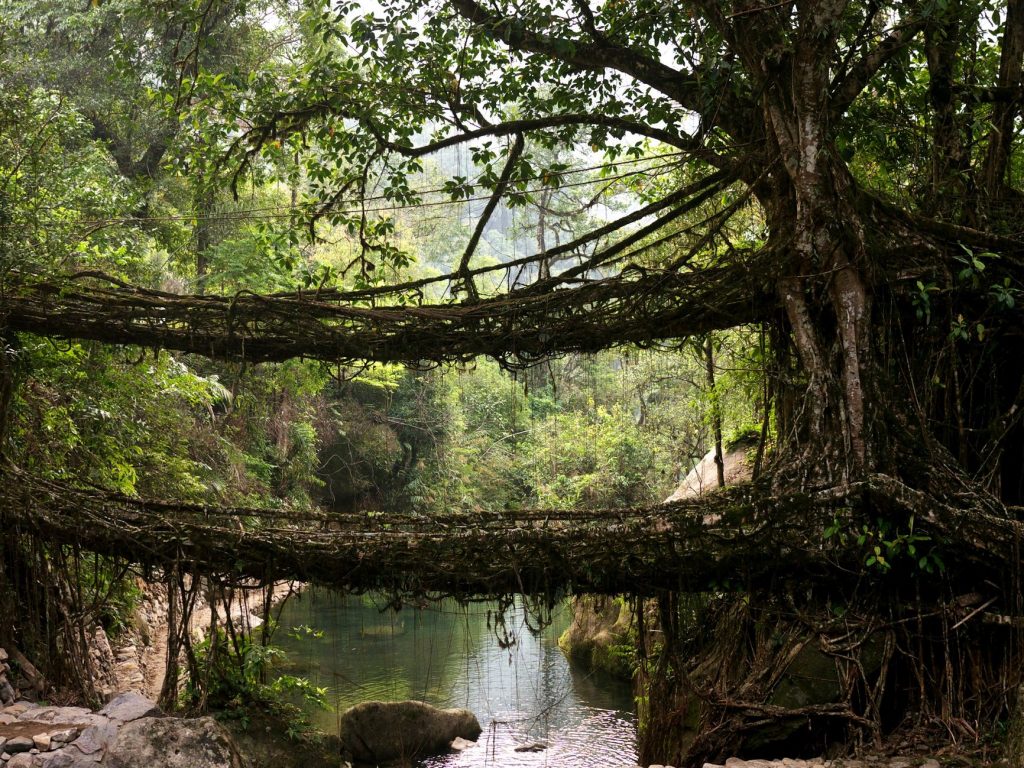
Meghalaya is known as a living root bridge came into the picture some two centuries ago i.e. nearly 180 years when veterans of the Khasi clan living in Meghalaya put rubber tree roots into hollow canes of Areca nut palm that met halfway across the stream. The roots were nurtured and cared for properly until they grew enough to reach the opposite bank, get completely entwined with each other, and make themselves capable enough to carry heavyweight. The incessant monsoons (June–August) result in the swelling of rivers and streams, making it impossible for the locals to cross the river on foot. So the indigenous Khasi tribe erected bridges that could withstand the heavy rains
These bridges are made by Khasi and Jaintia tribes who have mastered the art of wrapping thick roots together to form a structure that has the capacity to hold more than 50 people at a time. The living root bridges of the Khasi tribe grown from rubber trees are native to the region – The double-decker root bridge are all located near the Bangladesh border – There are 11 functional root bridges in this area and the most popular one are Ummunoi Root Bridge, Umkar Root Bridge, Ritymmen Root Bridge, Umshiang Double Decker Root Bridge & Mawsaw Root Bridge
Meghalaya’s most famous root bridge, the “double-decker” root bridge, can be found in the vicinity of one of the wettest places on earth – Cherrapunji (also known as Sohra). There are 11 functional root bridges in this area, situated about two and a half hours drive from Shillong. The bridges have been documented as far back as 1844, in the Journal of the Asiatic Society of Bengal by a retired Tamil banker who’s married to a local Khasi woman) in Laitkynsew village who put them on the tourist map. He spent a lot of time exploring the surroundings and detailing interesting treks when setting up the resort. The treks to the root bridges vary in duration and level of difficulty. The most well-known ones, which are all near the Resort, are:
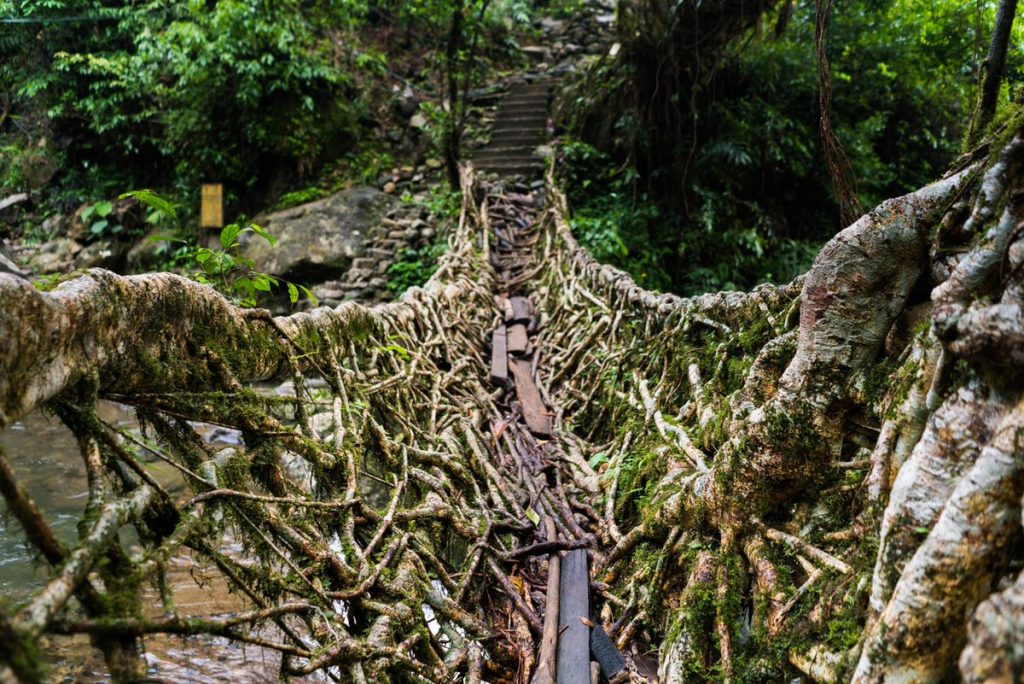
Ummunoi Root Bridge: Start from Laitkynsew village. Location: Ummunoi river near Siej village, Nongkroh, via Sohsarat village. Duration: Two kilometers one way. Three to four hours return. Descent: 1,400 feet. This 17 meter (54 foot) root bridge is one of the oldest known root bridges in the region and is perhaps the most popular with tourists due to its combination of accessibility and impressiveness.
Umkar Root Bridge: Start from Siej village. Half a kilometer one way. 30 minutes return. The best option for those who are lacking in fitness or mobility, this root bridge was partly washed away by flash floods. The villagers are in the process of regrowing it, which is interesting to see. There’s a waterfall alongside the bridge during the monsoon season.
Ritymmen Root Bridge: This can be visited on the way to the Double Decker root bridge. Starting point: Tyrna village. Location: Nongthymmai village. Duration: One and a half to two hours return. This 30 meter (100 foot) root bridge is the longest known living root bridge. Beautiful bridges by engineers are practical structures; when Mother Nature herself becomes the architect, the result is nothing short of breathtaking.
Umshiang Double Decker Root Bridge: Start from Tyrna village. Location: Umshiang river at Nongriat village. Duration: Three kilometers one way. Four to five hours return. Descent: 2,400 feet. The “holy grail” of root bridges, the unique 20 meters (65 foot) double-decker root bridge requires determination to reach but it’s worth it. Not everyone can go there though. It’s imperative that physical condition be taken into account.
Mawsaw Root Bridge: If you’re not too exhausted and have the time, continue to walk around 20-30 minutes past the Double-Decker root bridge. The natural swimming pools near this root bridge are a highlight (they’re unsafe during the monsoon season though). These natural wonders are among the popular attractions of this northeastern state of India.
Mawlynnong Living Root Bridge: An alternative to the root bridges around Cherrapunji, there’s also a substantial root bridge near Mawlynnong village and it’s readily accessible. The village is located near the Bangladesh border, around three hours from Shillong. To reach the root bridge, drive to Riwai village, a few kilometers before Mawlynnong. From there, it’s approximately a 15-minute walk one way.
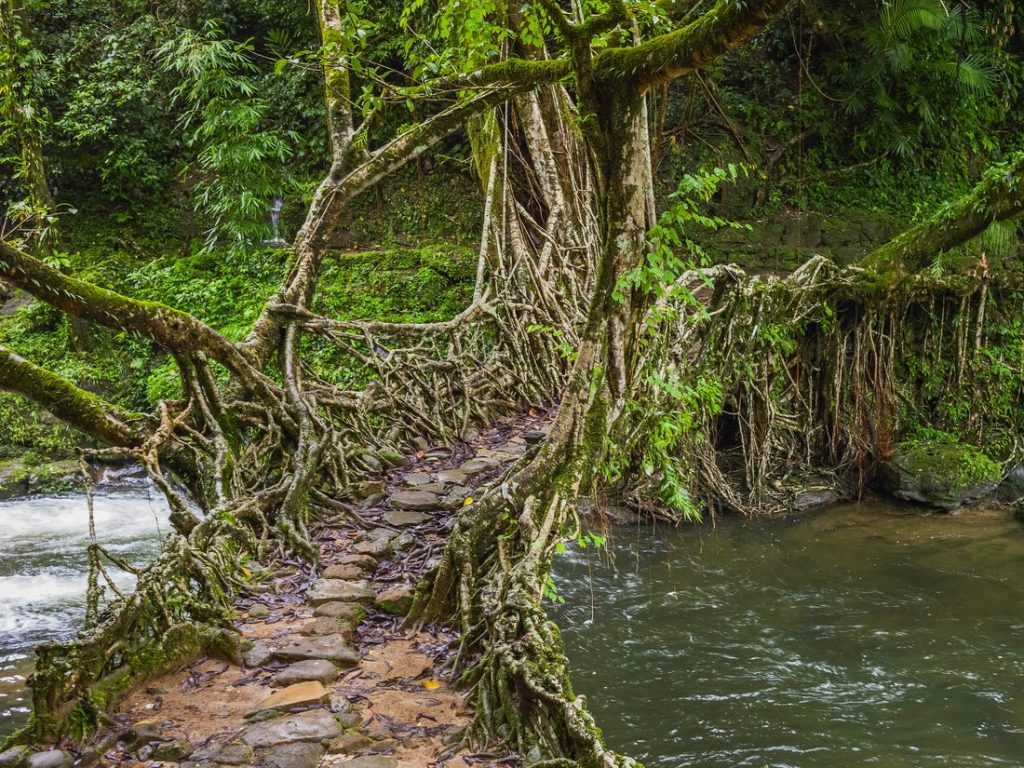
The legendary double-decker root bridge at Nongriat village near Cherrapunji, in northeast India’s Meghalaya state, beckons outdoor enthusiasts with the chance to see a 150+-year-old man-made natural wonder that’s not only unique but astounding. While there are many single root bridges in the area, this is the only one that has two levels. Apparently, local Khasi tribe members grew the second level after an unprecedented wet monsoon season caused water to reach the first level. A third level is planned, but only to capitalize on the bridge’s tourism potential. The beauty and cleanliness of the village is also outstanding. It’s obvious that the residents have high regard for the environment. While the root bridge is undoubtedly remarkable, its surroundings feel like a place where magic happens. There are waterfalls and natural swimming pools, clusters of huge brightly colored butterflies, mysterious sounds of the forest, and so much ancient wisdom. Visiting the double-decker root bridge is not easy. The trek there is long and tiring. It’s worth it though, for an out-of-this-world experience that’s guaranteed to be a highlight of your travels. The reality is that you don’t have to be fit. However, if you have any joint or mobility issues, or are not in decent physical condition definitely don’t do it (there are other easier options to see the living root bridges). The trek is very steep in parts and will put a lot of strain on your muscles.
The trek generally takes two hours each way. By walking at a leisurely pace there and a steady pace on the way back and an hour spent relaxing at the double-decker root bridge. So, all up, the trek ends in five hours. The path to the double-decker root bridge is three kilometers (nearly two miles) long. It has approximately 3500 stairs and descends 2400 feet. Those are some daunting figures, but don’t let it demoralise !! There are three parts to the trek. The steepest and most challenging part is the first part, down the hill to Nongthymmai village (where the longest root bridge, Ritymmen, is located). It takes about 45 minutes, along a seemingly endless trail of steps that plunges deeper and deeper into the forest. It seems like paradise, with jack fruits and pineapples growing wildly amid the jungle of vegetation is worth watching. Nongthymmai is a surprisingly attractive village of beekeepers with neat cement paths, well-groomed flower gardens, and a blue and white painted church. From there, it takes at least another hour to reach the double-decker root bridge.
The remaining two parts of the trek, which involve crossing narrow steel suspension bridges over raging rivers, are much flatter and less taxing. However, this, as well as the steep descent, may make the trek challenging for anyone who’s afraid of heights or has vertigo. Just as start doubting whether you’ll ever get there, after tackling yet another ascending staircase you’ll be greeted with a sign announcing Nongriat village. Drag yourself up the final set of stairs, look down, and there it will be like something from a fairytale the double-decker root bridge with its gnarly thick roots covered in moss.
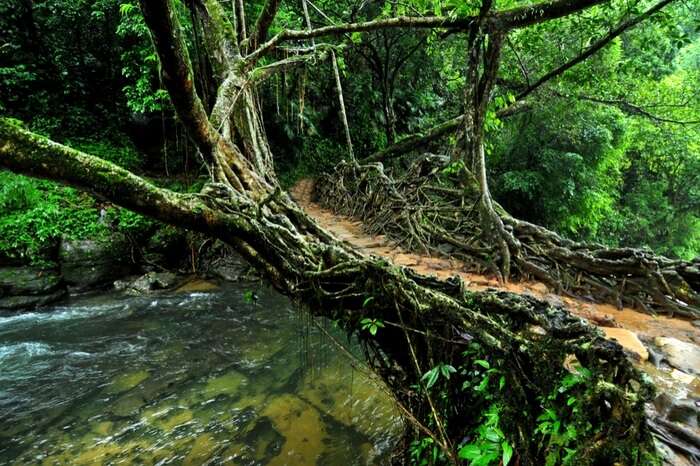
Some of the interesting facts about these bridges are:
The Living Root Bridges are made from rubber tree roots also known as Ficus elastica tree.
Some of the root bridges are over 100 feet long and take 10 to 15 years to attain the perfect shape.
Once fully grown, these roots last for as long as 500 years. While some of the roots decay because of their continuous association of water, others grow and make up for the decayed, thus providing the required stability to the bridge.
Of all the Living Root Bridges in Meghalaya, the double-decker root bridge in Cherrapunji and the single-decker root bridge in Shillong are the unique bridges in the world and make for prime attraction in the Northeast.
Living Root Bridges in Meghalaya are recognized by UNESCO as a World Heritage Site.
Weather: Cherrapunji is known as one of the wettest places on earth. The rainy season starts in April and continues until October. Most of the rain is received during June and July. It rains intermittently during the rest of the monsoon months. Rainfall usually occurs during the morning. (When I did the trek in mid-May, the morning was wet but the afternoon was sunny). You’ll find a useful rainfall chart here. In January (the dry winter season), the average maximum temperature is 16 degrees Celsius/60 degrees Fahrenheit. This drops to around 5 degrees Celsius/41 degrees Fahrenheit at night. In July (the wet monsoon summer season), the average temperature increases to a maximum of 22 degrees Celsius/72 degrees Fahrenheit during the day. At night, it drops to an average of 18 degrees Celsius/65 degrees Fahrenheit.
Dress: You may be tempted to wear a raincoat or other wet weather/winter clothing. However, it’s actually preferable to wear as little as possible. Due to the strenuous nature of the trek, you’ll get hot very quickly. Your clothes will become saturated with sweat and it’s much more comfortable to let your skin breathe. In regards to footwear, choose comfortable shoes that have a good grip. (Sandals are fine, particularly if they’re proper walking sandals such as Birkenstocks, which is what I wore).
What to Take: If you’re concerned about the rain, it’s a good idea to bring an umbrella. Pack some food and water, as you’ll only find a couple of shacks selling packaged drinking water and snacks along the way from Tyrna to Nongriat village. You’ll be able to get basic Indian vegetarian meals at Nongriat. Wearing a cap and sunscreen is recommended if you have fair skin. Mosquitoes are present in the evening, so you might want to consider mosquito repellent as well. It’s possible to go swimming in the natural pools at the double-decker bridge, so bring appropriate swimwear if you want to do this (it’s really refreshing and change rooms are provided). Do be aware that everything you take adds to the weight though, and you’ll really feel it when hiking back up the hill.
Homestay: There are a few guesthouses and homestays in Nongriat village that provide very basic accommodations. If you have the time and don’t mind some discomfort (minimal facilities are provided), it’s worth staying a night or two as the surrounding scenery is spectacular. You can trek to waterfalls, natural swimming pools, and other root bridges from the village. Again, pack as light as possible, as you’ll struggle with carrying a heavy backpack.
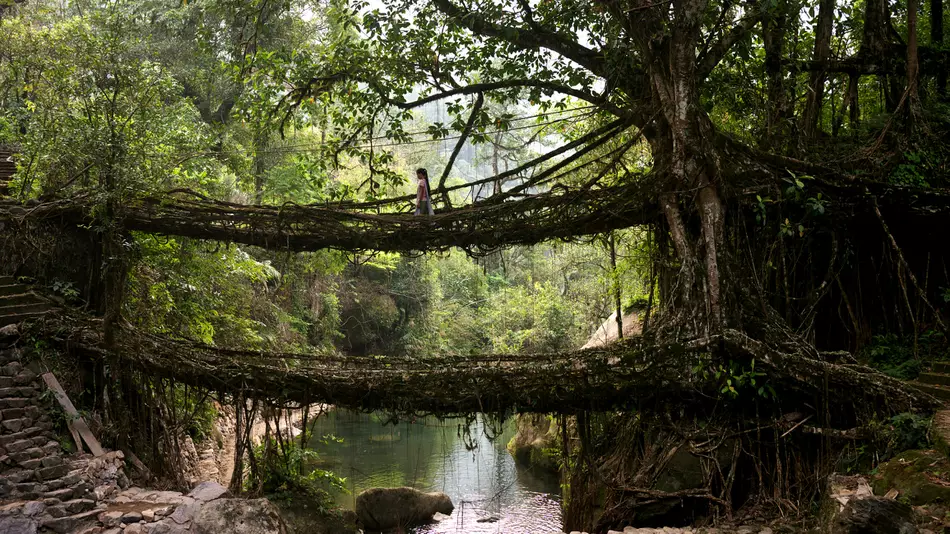
Other Things to Note: Entry and camera fees are payable at the double-decker root bridge. The cost is 10 rupees for adults, 05 rupees for children, and 20 rupees for a camera. The local Khasi people are very conscious of their environment and maintaining its cleanliness. Indian-style (squat) toilets are available at the double-decker bridge, and there’s a fine of 500 rupees for anyone caught relieving themselves in the forest or throwing rubbish. Aim to be back at Tyrna by 05 PM at the latest, as it starts getting dark early there. It’s not necessary to take a guide, although many people do, as the pathway is signposted.
Communication: The trek to the double-decker root bridge starts at Tyrna village, around 30 minutes past Cherrapunji (and not far from Laitkynsew village). It can be comfortably done on a day trip from Shillong. By air: Guwahati airport at a distance of 123 kilometers from Shillong, is well connected with major airports in India. Reserved cabs are mostly preferred by people to come down to Shillong from the airport. Shillong to Cherrapunji is 54 kilometers, which is a 02-hour ride by a local bus or a cab. By train: Guwahati Railway Station is the nearest railhead to Meghalaya. It is very well connected to other major railway stations across India and commuting to Shillong and other major cities of Northeast India is quite convenient. The 148 kilometers distance between Guwahati to Cherrapunji can be covered in 04 hours by a taxi or a private/government bus. By road: Volvo buses and government buses run from Guwahati to Shillong and Cherrapunji run in tandem at regular intervals. The 99 kilometers distance between Guwahati to Shillong is full of exciting views, which is indeed a treat for all travelers.
Visit: www.dreamwaydestinations.com & www.visittobengal.com Or Call us at +919733465000 & +919474092500 Or WhatsApp : +918617432205 Or Mail Us : info@dreamwaydestinations.com